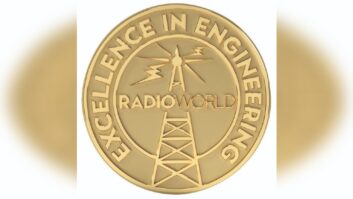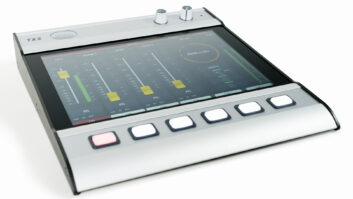The Digital Toolbox
Sep 1, 2013 8:00 AM, By Doug Irwin, CPBE DRB AMD
If you are working as a one-man-band engineering department, then it makes sense to provide yourself with the tools that increase productivity (read: make your job easier). Few things are more useful these days than tools that make installing and maintaining Ethernet easier and faster. To that end, I have assembled some tools and ideas to facilitate that process.

I hate walking back and forth between two ends of an Ethernet cable run that is pulled through the ceiling and wall only to find that one end has a problem. (Which end is it!?) The simple way to get around this is to just pick up a cable tester with a terminating device. Just one example (and there are many) is the Tripp Lite (Model N0-44) Network cable tester. To test the cable run, plug the remote device into the jack to be tested with a cable (it doesn’t plug directly into the jack.) Then test the cable run (and all intermediate connections) for shorts, opens and miswiring. This device is really made for office/cubical installers, so it has provisions to test RJ-12, BNC and type F connectors as well.
Perhaps you have a bit more money to spend on this particular tool; if so you might consider something like the Hobbes (model 256003) LANsmart. With this device you can not only check cable wiring (shorts, opens, miswiring, reversals) but you can also use LANsmart’s built-in time domain reflectometer to check the cable length and for the distance back to any opens or shorts in a cable. Another neat feature this one has is its ability to send audio signals on selected pins on the cable – useful for tracking down mystery cables.
More and more Ethernet-powered devices are showing up around the radio station and the transmitter site — including VoIP phones, wireless access points, IP cameras, and the like. The ability to test the current-handling capability of Ethernet wiring has become crucial, and for that reason the Psiber Lanmaster 35 is a tool that you may want to consider having in-house. This device conducts power tests over the Ethernet wiring and verifies its ability to pass current from the far end power source. It measures the loop resistance so that you can identify damaged cables and bad punches. It also happens to provide link speed and duplex modes as well as cable length.
Beyond the connector
Of course we don’t want to limit the topic to just Cat-5/6 cables with RJ-45s on them. Wi-fi access points are commonly used around radio stations as well. Clearly there are devices and software out there made for Wi-fi analysis. Let’s take a look at a well-known one: inSSIDer (office version) from MetaGeek. This is an inexpensive hardware and software package that allows you to walk around the service area with a laptop PC and do simple analysis of Wi-fi issues. A small USB device (Wi-spy) is used to characterize local RF activity, and the software combines that information with that gathered from the PC’s Wi-fi card to tell you what networks are available, their signal strengths, interference sources, and non-standard channel usage. The analysis results in a link score (100 being the max) and more importantly the software tells you how to improve that score (for example, by changing channels).
If you find the software-based solution inadequate then you can always opt for a hand-held tester such as the Fluke Aircheck. This device would be especially handy if you were setting up a new Wi-fi access point at the station, or transmitter site, or even at a temporary site (a remote broadcast, for example). For starters, it performs tests to see whether the proposed location will even work by looking for already existing Wi-fi and non-Wi-fi signals on a channel by channel basis, as well as for interference sources, which can include microwave ovens, cordless phones, and Bluetooth devices.
Assuming you find your proposed site will work, and you complete the install, Aircheck can then be used to perform tests to see how well your new Access Point is working by playing the role of a Wi-fi client, associating itself with the AP, requesting an address by way of DHCP, and then pinging the gateway or other user-defined addresses. If the site develops problems later on, you could use Aircheck to verify the coverage, analyze interference, security settings, and even potentially negative effects of rogue access points. It can determine if channels are overloaded due to Wi-fi traffic or interference and/or overlap with other APs.
Even with the proliferation of wireless devices, cable (and fiber) testers play an important role in the broadcast plant. For the hard connections you may want to consider a device such as the Fluke LinkRunner AT (LRAT-2000). Not only will this device help you figure out simple issues at the physical layer (i.e., cable and connector issues), but it will do much more. For example: Say you find yourself walking into a new radio station or an otherwise different rack room loaded up with Layer-2 switches and Ethernet patch-fields. Labeling is (shall we say) sub-standard. You have no idea where Ethernet cables that start out in the sales office (for example) end up in this room. So what do you do? Well you could plug the LinkRunner into the far end mystery Ethernet jack and find out quickly where it shows up in the computer room. The connectivity test (using LLDP or Cisco CDP or EDP) will tell you the name of the switch to which you are connected, along with its management IP address and the port, slot and VLAN of the mystery Ethernet jack and even its duplex and speed configuration, along with the actual (measured) speed and signal strength. Is this jack for a VoIP phone by chance? Well the LinkRunner will also tell you the PoE voltage and the ability of the jack to pass current.
About a year ago I was bringing up a new 100Mb/s Ethernet radio that connected Clear Channel’s NYC backup facility in New Jersey with our backup transmitter site at 4 Times Square and an issue arose: What do I do to test the Ethernet throughput of this system? I knew the link was working at the Layer-3 level because I was using a browser to communicate with the far-end radio. I could have used a LinkRunner for purposes of testing a radio link such as this, because another one of its features is its packet reflector mode, which allows it to be used as a remote device for throughput tests to validate LAN or WAN connectivity (up to 1Gb/s). The originating device for a test such as this would be anything that generated 802.3 frames or IP packet streams.
Software tools
Surely there must be plenty of software offerings out there that allow you to test networks just by plugging an Ethernet cable in to your computer, right? Well let’s take a look at just one: PacketCheck from GL Communications. PacketCheck is a PC-based Ethernet/IP testing application with the following features (among others):
� It can transmit or receive full-duplex Ethernet/IP/UDP traffic at rates up to 800Mb/s for testing of LANs or WANs
� For Metro Ethernet testing, it supports stacked VLAN with customizable Type Field, VLAN ID and Priority.
� For MPLS testing, it supports customizable stacked MPLS with Label, CoS and TTL fields.
� It will generate multiple streams simultaneously, each with independent configurations.
� Monitors performance specifics such as throughput, round trip delay, one-way delay, total packets, packet loss, out-of-sequence frames, correct frames, and error frames.
It’s important to note though that the looped measurements require another PC at the far end that turns the data back around and returns it to you.
PacketCheck Command Line Interface (CLI) supports all the functionalities of PacketCheck that can be accessed via commands, instead of the GUI. The CLI can be accessed through GL’s proprietary WCS (Windows Client Server) architecture, thereby allowing remote execution of commands.
You may have noticed by now that as I continue with the devices in this article, the price point continues to rise. I hesitate to write “if money were no object �” because this is broadcasting after all, but if you have adequate money to allocate to this sort of test equipment, then you should at least take a look at the JDSU SmartClass Ethernet. This is a very powerful hand-held network testing device with the following features (and more):
� Electrical and optical testing in one package; cable diagnostic tests checks cable length, type, and displays type of fault and distance. Optical power measurement to check laser levels.
� Line rate traffic generation at Layer 2 and Layer 3
� IETF RFC 2544 for throughput verification and line qualification
This would be the kind of device you could carry around as opposed to a laptop PC. (It certainly has an advantage over a PC in that it has the optical power measurement capability.) Its ability to generate ping and traceroute messages means that you can test out WAN connectivity easily enough. It has both a loopback and a traffic generation mode, which implies that you would need two such devices for end-to-end testing.
Having the right tools for the job is the key to getting it done quickly and efficiently. Tools for testing Ethernet and IP connections are now no less important than are DVMs, wattmeters or audio analyzers, and a well-equipped shop should include will have them all.
Irwin is RF engineer/project manager for Clear Channel Los Angeles. Contact him at [email protected].
September 2013
Digital test devices, Red River Radio rebuilds, vertical radiators explained, Field Report on the Tieline Merlin Plus, Z100 celebrates 30 years and more….












